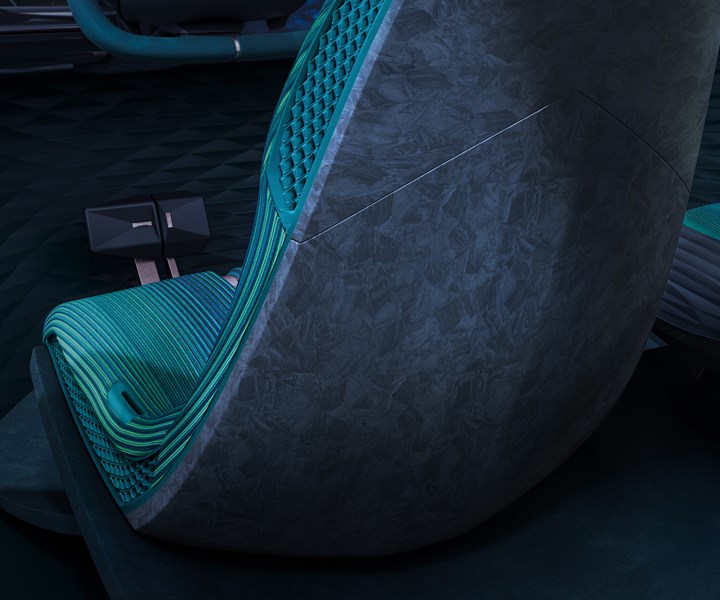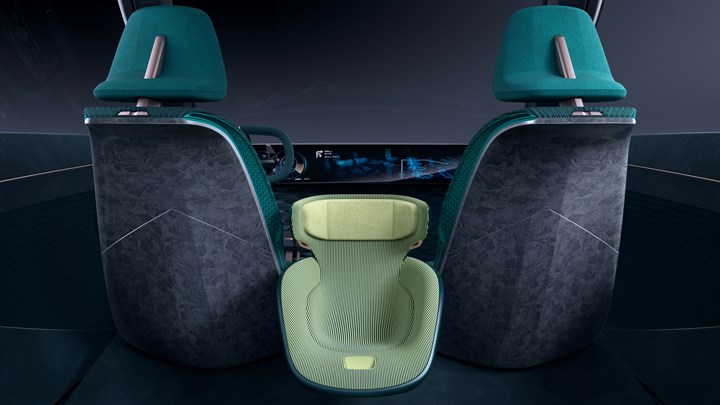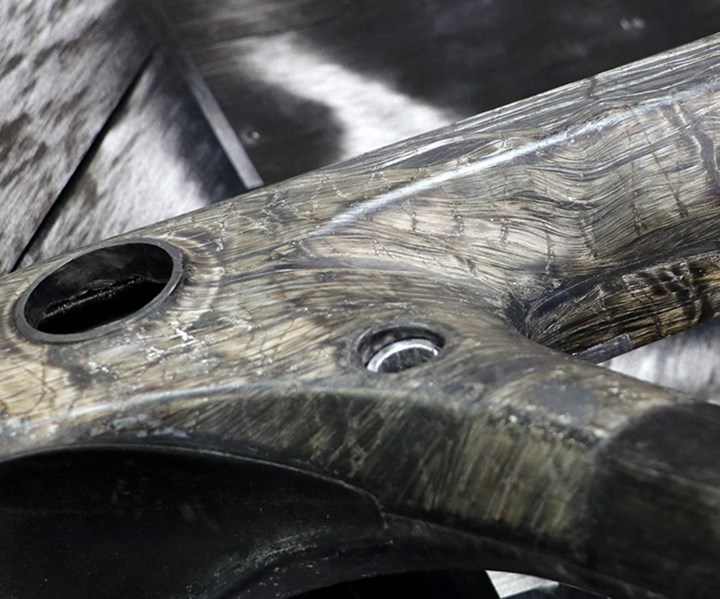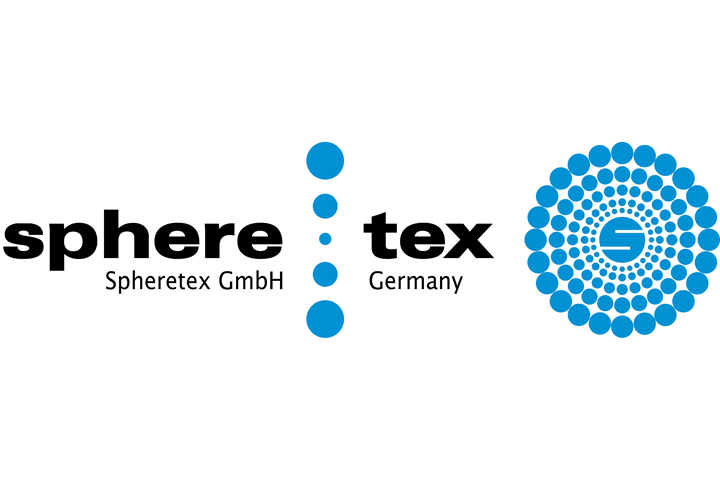CompositesWorld News for Jan. 23, 2020
Read news from Covestro, AnalySwift, and Spheretex
Thermoplastic composites incorporated into vehicle seatback concept
Covestro’s Maezio carbon fiber-reinforced thermoplastic composites were used to develop a lightweight, sustainable seatback concept for a Chinese car manufacturer.

Source | Covestro
Covestro (Leverkusen, Germany) announced on Jan. 14 that it has partnered with the Research and Development Center of Guangzhou Automobile Group Co. Ltd. (GAC R&D Center; Guangzhou, China) to develop a lightweight composite seat back for the car manufacturer’s latest electric concept car, the ENO.146.
The ENO.146 is designed to be a highly aerodynamically efficient vehicle, with a drag coefficient of only 0.146 and a New European Driving Cycle (NEDC) range of 1,000 kilometers. Efforts to reduce vehicle weight and increase sustainability have resulted in the selection of Covestro’s Maezio carbon fiber-reinforced thermoplastic composite (CFRTP) material for the backrests of the concept car’s front seats. Compared to typical metal constructions, the CFRTP seat backrest results in estimated weight savings of up to 50%.
“Seats in the passenger compartment are an ideal target for weight savings, as they are among the heaviest parts there,” says Lisa Ketelsen, head of Covestro’s thermoplastic composites business. “Fiber-reinforced composites are the ideal material for lightweight automotive construction, but Maezio can further simplify molding and streamline the manufacturing process.”
According to Covestro, fittings and other attachments add to the complexity of production and assembly for seats with metal backrests. Because Maezio is a thermoplastic material, parts and functions can be consolidated by injection molding processing. Functional structures are incorporated into the mold for shaping the backrest, reducing the number of parts and materials.

Source | Covestro
The backrest also needed to meet the aesthetic and sustainability goals of the vehicle interior, which was designed with green colors and patterns reminiscent of nature and to incorporate sustainable or recyclable materials. The Maezio material is able to be cut and shaped into the desired marble-like pattern, fitting aesthetic requirements, and can be reused at the end of its service life, which suited the team’s sustainability needs.
“Mobility trends such as electrification and autonomous driving are redefining the role and function of car interiors,” says Zhang Fan, vice president of the GAC R&D Center. “There is a growing need for material solutions that are lightweight and sustainable while opening up ways to create new user experiences ranging from visual to tactile feedback.”
The vehicle recently made its debut at the Guangzhou International Automobile Exhibition.
REIN4CED to produce composite bicycle frames for Accell
REIN4CED recently opened an automated production facility in Belgium to produce hybrid carbon fiber and steel composite frames for Accell mountain bikes.

Source | REIN4CED
On Jan. 16, Accell Group (Heerenveen, Netherlands) and REIN4CED (Leuven, Belgium) announced that they are collaborating on the automated production of hybrid carbon fiber and steel composite bicycle frames for Accell, with plans for new hardtail mountain bikes to be on the market by mid-2020.
Michaël Callens, CEO of REIN4CED, says the company’s new FEATHER material used for the bicycle frames is a hybrid carbon fiber and steel composite material that is designed to offer extreme impact resistance.
To produce composite frames for Accell’s line of Ghost hardtail mountain bikes, REIN4CED set up a new automated manufacturing facility in Leuven, Belgium, shifting production from its Asia facility closer to Accell Group’s Netherlands location to provide logistic and sustainability advantages as well as increased supply chain flexibility and efficiency. According to REIN4CED, the new facility is capable of producing an annual capacity of up to 20,000 frames.
The companies plan for the new bicycle line to be available to customers in Germany, Spain, Austria, Switzerland, Italy and the Czech Republic.
“This collaboration matches Accell Group’s global innovation strategy and ambition to increase sustainability in its products. With enhanced durability and safety through local production and maximum performance for our cyclists with the new FEATHER technology. In two words: this innovation is smart and green,” says Ton Anbeek, CEO of Accell Group.
AMRC develops 3D woven composite components for fusion nuclear reactor
The University of Sheffield AMRC is developing a ceramic composite breeder blanket capable of withstanding the extreme temperatures in a nuclear reactor.

Source | AMRC
The University of Sheffield Advanced Manufacturing Research Centre (AMRC; Catcliffe, U.K.), in collaboration with the United Kingdom Atomic Energy Authority (UKAEA; Abingdon, U.K.), is developing a 3D woven composite breeder blanket component capable of withstanding extreme temperatures inside a fusion nuclear reactor, as part of an effort to accelerate delivery of limitless zero-carbon fusion energy.
The work was commissioned by the Joining and Advanced Manufacturing (JAM) program, which forms one of three Fusion Technology Facilities at UKAEA. The AMRC, part of the High Value Manufacturing (HVM) Catapult, worked with Dr. Lyndsey Mooring, technical lead for non-metallics at UKAEA, to explore how composite materials could produce components that are stiffer, lighter and easier to manufacture than those currently in use, but which retain the necessary capabilities.
The UKAEA is involved in developing a next-generation magnetic confinement reactor — called a tokamak — at its site in Culham, Oxfordshire, U.K. Research is focused on preparing for an international tokamak experiment at the International Thermonuclear Experimental Reactor (ITER) in Saint-Paul-lès-Durance in southern France, and for the subsequent machine intended to demonstrate the generation of power from fusion.
In September 2019, the UKAEA announced that it would be building a new £22 million fusion energy research facility at the Advanced Manufacturing Park in Rotherham, U.K., that includes a test facility that reproduces the thermohydraulic and electromagnetic conditions in a fusion reactor. The center will work with industrial partners to commercialize nuclear fusion as a major source of low-carbon electricity.
Fusion occurs when two types of hydrogen atoms, tritium and deuterium, collide at enormously high speeds to create helium and release a high-energy neutron. Once released, the neutron interacts with a much cooler breeder blanket to absorb the energy. The breeder blanket must capture the energy of the neutrons to generate power, but also prevent the neutrons escaping and ‘breed’ more tritium through reactions with lithium contained in the blanket. Each blanket module typically measures about 1 by 1.5 meters and currently weighs up to 4.6 metric tonnes.
Up until now, breeder blanket designs have been made of steel, but the AMRC’s research involves developing a design that uses silicon carbide composite materials formed into a 3D woven structure with additively manufactured components.
“At the moment, the designs being tested in ITER use steel for the breeder blankets structure, which have a network of double walled tubes of 8-millimeter internal diameter and 1.25-millimeter wall thickness to collect the heat. Each one is welded into place and every connection has to be inspected. That is what we were asked to replace,” says Steffan Lea, research fellow at the AMRC Composite Centre. “Currently, their steel modules are limited to approximately 500˚C, so UKAEA asked us if there was anything we could do to get it up to 600˚C. We set out to see what materials we could use, that would enable higher temperature operation.”
For the proposed composite breeder blankets, the cooling tubes would be integrated into the material, and 3D-printed parts used to define features such as connectors and manifolds.
“We wanted to maximize the available surface area for heat transfer while being as lightweight as possible, but ensure it occupied a similar volume to the existing breeder blanket designs,” says Joe Palmer, senior project manager at the AMRC’s Design and Prototyping Group. “To achieve a lightweight, temperature-resistant structure, a silicon carbide composite material was chosen for the breeder blanket, with the internal flow channels being created by forming the composite around a disposable core.”
After a computer-aided design (CAD) model was produced, Chris McHugh, dry fiber development manager at the AMRC Composite Centre, created a weave design for the composite. “The design I created had multiple weave zones and had multiple layer weaves. The structure needed holes robust enough to include tubes and needed to maintain the preform shape without distortion. What we were able to produce on the loom was a 3D woven structure with pockets for the 3D-printed tubes which could be formed into a ridged component,” McHugh says.
The next step, according to Dr. Elizabeth Surrey, head of technology at the UKAEA, is to continue silicon carbide composite development and build a demonstrator that can be tested inside a reactor test facility in order to understand how it performs and reacts to the environment.
“If nuclear fusion is going to be realized, you need a simple design for breeder blankets that are manufacturable and easily replicated. That is what we have tried to create,” Surrey says.
AnalySwift receives NASA grant to improve design of composite deployable structures
The $125,000 grant will further development of SwiftComp software to improve modeling and design for deployable structures built from high-strain composites.

This image shows some of the high-strain composite deployable booms under development at NASA Langley Research Center. Source | NASA, via Purdue University
AnalySwift LLC (West Jordan, Utah, U.S.), a Purdue University-affiliated commercial software provider, announced on Jan. 21 that it has received a $125,000 Small Business Technology Transfer (STTR) grant from NASA to further develop of its SwiftComp software, technology that provides efficient, high-fidelity modeling of deployable structures made of high-strain composites.
According to Allan Wood, president and CEO of AnalySwift, the software would help NASA engineers model high-strain composites with a tradeoff between efficiency and accuracy that were unreachable using more conventional methods. Wood says that NASA is looking to use the software technology, in part, to study deployables made of high-strain composites that are lightweight and feature time- and temperature-dependent behavior.
In addition to deployable composite booms, NASA could leverage the software for structures such as living vessels, foldable panels, hinges and reflectors, as well as lightweight structures such as satellite buses, landers, rovers, solar arrays and antennas, according to AnalySwift. Other applications include highly flexible wings for future aircraft and highly fatigue- and damage-tolerant structures for vertical lift aircraft.
In a program launched in early 2019, the software also has been licensed to companies and universities worldwide, including those using it for work on satellites and mobile phone components such as printed circuit boards.
SwiftComp technology was developed by Wenbin Yu, a professor of aeronautics and astronautics in Purdue’s College of Engineering. AnalySwift licensed the technology from the Purdue Research Foundation Office of Technology Commercialization.
“The unique synergistic relationship between Yu’s computational mechanics research group at Purdue and AnalySwift, with its SwiftComp simulation software, makes it a very efficient transition mechanism of new material and structures fundamental theory developments into the commercial world,” says Juan Fernandez, a research aerospace engineer with NASA. “The ultimate goal is to increase the capabilities of this commercial computational tool so that others in the high-strain composites community can benefit from it and help advance the field, while using it to satisfy current and future NASA program modeling needs.”
“This project will help expand the application of SwiftComp to composite structures and materials used in space environments featuring temperature- and time-dependent behavior,” Yu says.
Glass fiber core manufacturer Spheretex moves to new facility
The company announced that it has moved to a new production and warehouse facility in Neuss, Germany as of Jan. 1, 2020.

Glass fiber core material manufacturer Spheretex GmbH recently announced that it has moved into new facilities in Neuss, Germany, as of Jan. 1, 2020.
After renting a facility for 20 years, Christoph Esser, managing director at Spheretex, says that it is a big step for the company to now have the production facility and warehouse in one facility.
“It was a big challenge to ensure the move of the complex production machines,” says Günther Müller-Kössler, operations manager at Spheretex, “but we managed perfectly!”
The company experienced a 2-month production shutdown as all of the machinery was dismantled and moved to the new facility.
Related Content
Carbon fiber in pressure vessels for hydrogen
The emerging H2 economy drives tank development for aircraft, ships and gas transport.
Read MoreASCEND program update: Designing next-gen, high-rate auto and aerospace composites
GKN Aerospace, McLaren Automotive and U.K.-based partners share goals and progress aiming at high-rate, Industry 4.0-enabled, sustainable materials and processes.
Read MoreThermoplastic composites welding advances for more sustainable airframes
Multiple demonstrators help various welding technologies approach TRL 6 in the quest for lighter weight, lower cost.
Read MoreMaterials & Processes: Fabrication methods
There are numerous methods for fabricating composite components. Selection of a method for a particular part, therefore, will depend on the materials, the part design and end-use or application. Here's a guide to selection.
Read MoreRead Next
From the CW Archives: The tale of the thermoplastic cryotank
In 2006, guest columnist Bob Hartunian related the story of his efforts two decades prior, while at McDonnell Douglas, to develop a thermoplastic composite crytank for hydrogen storage. He learned a lot of lessons.
Read MoreComposites end markets: Energy (2024)
Composites are used widely in oil/gas, wind and other renewable energy applications. Despite market challenges, growth potential and innovation for composites continue.
Read MoreCW’s 2024 Top Shops survey offers new approach to benchmarking
Respondents that complete the survey by April 30, 2024, have the chance to be recognized as an honoree.
Read More
.jpg;width=70;height=70;mode=crop)





























